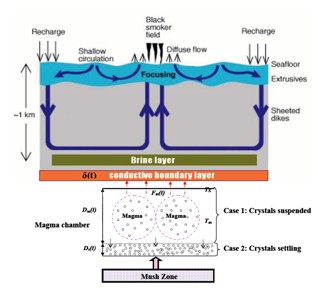Lowell
Modeling Hydrothermal Processes at Oceanic Spreading Centers
R.P. Lowell¹*, L. N. Germanovich², P.A. Rona³, K. C. Lewis⁴, P. Ramondenc⁵, L. Liu⁶, K. Craft¹, B.Crowell⁷, G. Genc², L. Han¹, R. Hurt², M. Steele-MacInnis¹, R.J. Bodnar¹, G. Garven⁸, M.K. Tivey⁹, J. Hoover¹,and K.L. Von Damm¹⁰
Corresponding author: rlowell@vt.edu
¹Virginia Polytechnic Institute and State University, Department of Geosciences, Blacksburg, VA 24061
²Georgia Institute of Technology, School of Civil and Environmental Engineering, Atlanta, GA 30332
³Rutgers University, Institute of Marine and Coastal Sciences, New Brunswick, NJ 08901
⁴University of Chicago, Department of Geophysical Sciences, Chicago, IL 60637
⁵Schlumberger, Integrated Productivity and Conveyance Centre, Sugar Land, TX 77478
⁶Georgia Institute of Technology, School of Earth and Atmospheric Sciences, Atlanta, GA 30332
⁷University of California, San Diego, Scripps Institute of Oceanography, La Jolla, CA 92037
⁸Tufts University, Department of Geology, Medford, MA 02155
⁹Woods Hole Oceanographic Institution, Woods Hole, MA 02543
¹⁰University of New Hampshire, Durham, NH 03824
Abstract:
We have been engaged for many years in developing mathematical and numerical models of hydrothermal processes at oceanic spreading centers and have been developing devices for measuring fluid flow and advective heat flux. Over the years our work has addressed a number of issues related to the fundamental physics of these systems, largely through the parameterized single-pass model approach, as well as a number of more complex phenomena. These have included: (a) the evolution of permeability as a result of thermoelastic stresses and mineral precipitation, (b) the formation of event plumes, (c) the propagation of dikes, (d) brine formation and storage, (e) the relationship between focused and diffuse flow, and (f) the production of biogenic sulfur floc in the shallow crust. Our current modeling efforts are focused on the hydrothermal response to earthquakes, serpentinization and deformation of the seafloor at slow spreading ridges, numerical modeling of multiphase flow and phase separation in NaCl-H2O fluids, coupled magma-hydrothermal models incorporating magma convection, crystallization, and replenishment, numerical modeling of reactive transport during hydrothermal recharge, and modeling quartz precipitation during multiphase hydrothermal convection. In the past few years, we have also made a number of measurement of both high-temperature and low-temperature advective heat flux at the East Pacific Rise and the Juan de Fuca Ridge.
Keywords:
magma-hydrothermal heat transfer; numerical modeling; heat flux
Contributions to Integration and Synthesis:
Hydrothermal processes at oceanic spreading centers are complex multi-scale, time dependent processes that by their very nature require a multi-disciplinary approach. Geologic, geophysical, geochemical and biological data all need to be interfaced into robust mathematical and numerical models. Currently our models use input from seismicity studies, vent geochemistry, seismic imaging of magma chambers, among others. Our goal is to develop robust models of hydrothermal processes that are relevant to a broad spectrum of mid-ocean ridge studies. We are looking for increased collaborations with biologists to better understand the fluxes of chemical species in low-temperature diffuse flows, with petrologists to better model magmatic processes, with geochemists as we try to incorporate more sophisticated water-rock reaction processes into our numerical models, and with tectonicists as we try to couple surface deformation with magma replenishment and eruptive processes.
Figures:
Figure 1. Schematic of a coupled magma-hydrothermal system. Vigorous Magma convection results in heat transfer Fm(t) to the overlying two-phase hydrothermal system. Two extremes of magma crystallization may occur: (1) crystals suspended or (2) crystals settling, which results in Fm(t) decreasing with time. Replenishment stabilizes Fm(t) as magma chamber grows laterally and vertically. Episodic replenishment and heat transfer across the conductive boundary layer results in changes in brine formation, vent salinity and temperature. Episodic replenishment may also generate stresses leading diking and eruption. Lowell_fig1.jpg

